Paving Stones vs Gravel: Which is the Best Choice for Your Outdoor Space?
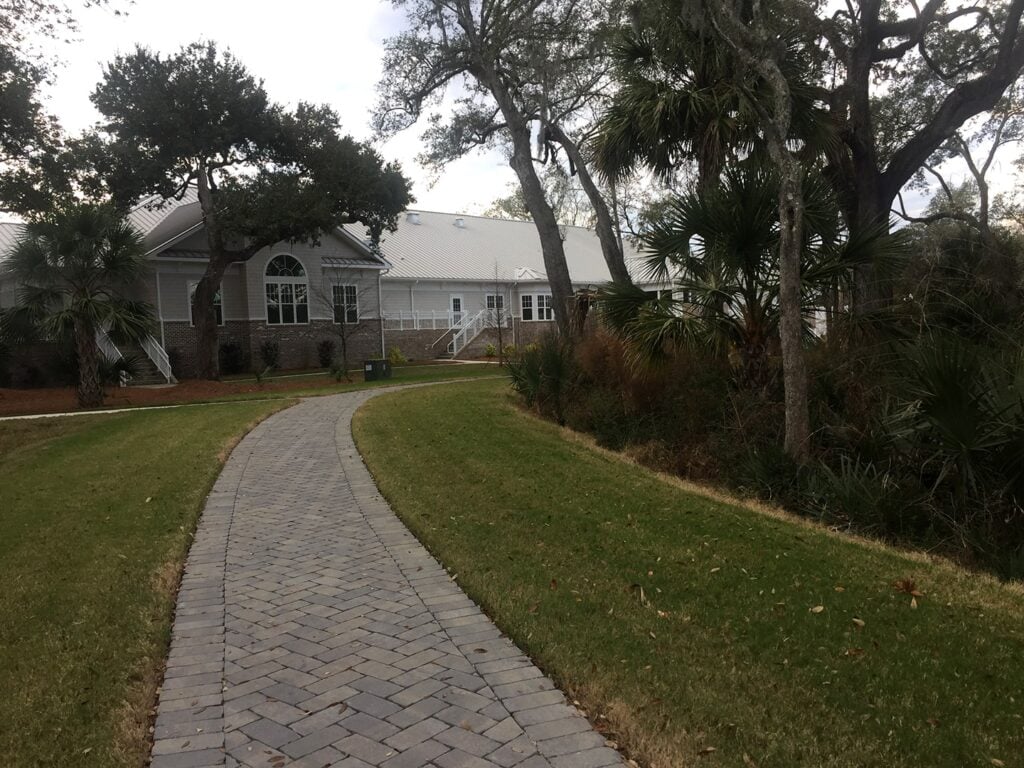
Whether creating a new patio, walkway, or driveway for your property or updating an existing space, it can be challenging to choose between two popular building materials; paving stones or gravel.
Paving stones and gravel are classic and rustically beautiful building materials that have been used for centuries worldwide.
When it comes down to it, what are the pros and cons of paving stones vs. gravel? Which one is right for your project?
It is essential to understand the nuances of each material to make an informed decision for your home or business’s new outdoor space.
Pros and Cons of Paving Stones vs. Gravel
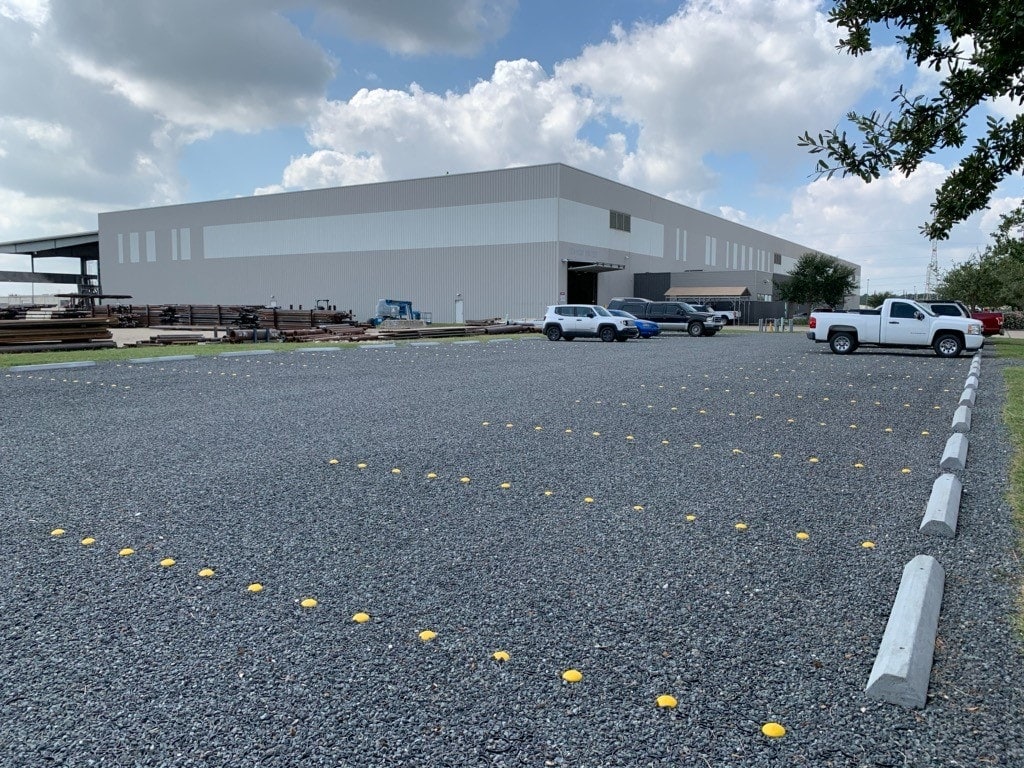
As with any building materials, there are a variety of pros and cons when comparing paving stones and gravel; each product offers distinct advantages and disadvantages when building a driveway, patio, or walkway.
Paving Stones – Pros
Paving stones, which can range from natural blue stone or granite to manufactured concrete pavers or bricks, can add beauty to any outdoor living area.
Paving stones can provide a classic beauty to your project, but it’s important to know that they also present some significant disadvantages.
Wide Range of Colors
One of the most significant advantages of paving stones is the vast array of colors that are available. From warm reds and sandy tans to cool blues and greys, paving stones can match any home or building’s color scheme.
Wide Range of Shapes
You can purchase paving stones as irregular, natural stone shapes to create a more organic, natural space or as straight-edged, ninety-degree rectangles or squares for a uniform, geometric style.
Barefoot-Friendly
Do you strongly prioritize walking around outside barefoot? If so, paving stones are a great barefoot-friendly paving option. A paving stone’s smooth, flat surface is much more comfortable for the tender undersides of your feet than sharp, irregular gravel.
Paving Stones – Cons
Expensive
When comparing the price of paving stones to gravel driveways, patios, and walkways, paving stones are significantly more expensive than gravel.
Not only is the material cost for paving stones more expensive than gravel, but the labor cost for installation is substantially higher as well.
Difficult Installation
Properly installing hardscape materials like paving stones can often require experienced professionals and specialty tools.
Knowing how to achieve an adequately prepared subsurface and accurately screeding to ensure a smooth, flat finished product is a skill many hardscape contractors hone with years of experience.
Specialty tools like plate compactors for adequately compacting the base to avoid settling and paver pullers are essential to completing a paving stone project.
Gravel – Pros
Gravel comes in a variety of shapes and sizes. From the traditional ¾” crushed gravel you are probably familiar with, to small, smooth, and rounded pea gravel, there is a type of gravel to fit every need.
Gravel patios, walkways, and driveways are popular in rustic French architecture, English cottages, and European villas.
Drought-tolerant landscaping also commonly uses different varieties of gravel in its design. Gravel driveways, patios, and walkways can be excellent ways to create permeable surfaces around your home as well.
Cost Effective
One of gravel’s most significant advantages over paving stones is its dramatically lower cost.
Not only is gravel’s material cost substantially more affordable than paving stones, but the installation costs and labor fees associated with gravel surfaces are a fraction of what it costs to install paving stones.
Easy Installation
Creating a gravel driveway requires minimal special tools and can be done by any motivated DIYer with a couple of weekends and some good old-fashioned elbow grease.
Superior Drainage
Gravel surfaces can be 100% permeable and offer unmatched drainage, by eliminating issues caused by runoff, like puddles and flash flooding. Additionally, the permeability of gravel surfaces helps to replenish your area’s natural groundwater supply, to create a healthier environment for you and your family.
Gravel – Cons
Rutting
Gravel driveways are notorious for developing ruts once consistently driven on. Ruts are unsightly and can eventually lead to a muddy driveway as well as pooling or puddling.
Erosion
Gravel driveways essentially consist of loose stone, so they can be susceptible to erosion. Unlike paving stones which have structure and firm borders, gravel surfaces built on a hill, slope, or grade can erode over time and become a hazardous mess.
Spillage
Over time, gravel can spill out of its defined boundaries and into adjacent lawns and gardens, which causes a messy living area and can create a potential lawn-mowing hazard.
Eliminate the Downsides of Gravel with TRUEGRID®
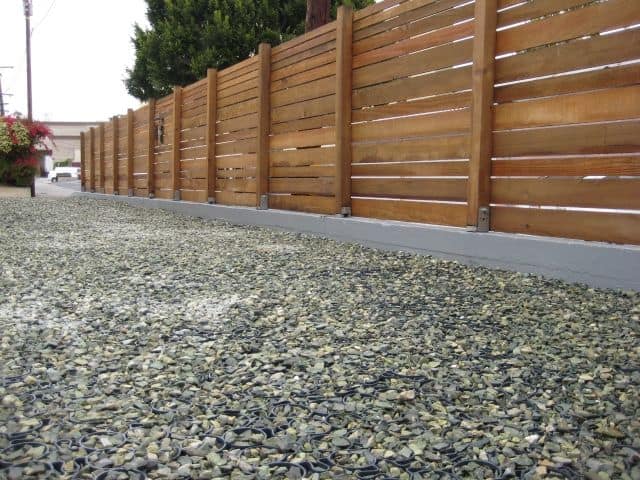
You can create a gravel surface without the downsides by pairing the rustic beauty of a gravel driveway, walkway, or patio with the practical and eco-friendly functionality of TRUEGRID® permeable pavers.
Installing the TRUEGRID PRO LITE or PRO PLUS permeable pavers on top of your subsurface and then filling them with gravel creates a gravel surface that is immune to irritating rutting and spilling.
TRUEGRID permeable pavers are interlocking plastic grids engineered with an open structure of tubes. TRUEGRID’s open design allows you to fill them with gravel while simultaneously locking the gravel in place; this prevents the irritating spilling that can often plague gravel surfaces.
TRUEGRID permeable pavers are engineered with industry-leading compressive strength, making rutting a thing of the past; the PRO PLUS can easily handle the weight of trucks and heavy machinery.
Want to build a gravel patio or walkway on a slope or with a pitch? By using TRUEGRID permeable pavers, you can prevent nasty erosion and lock your beautiful gravel surface in place.
Curious about creating a durable grass driveway, parking lot, or walkway? TRUEGRID’s innovative ROOT® system allows grass to grow through its structure while protecting grass’s delicate roots from being crushed by vehicle weight, so that you can create stunning and durable grass surfaces.
Choose TRUEGRID Permeable Pavers for Beautiful, Eco-Friendly Paving Options
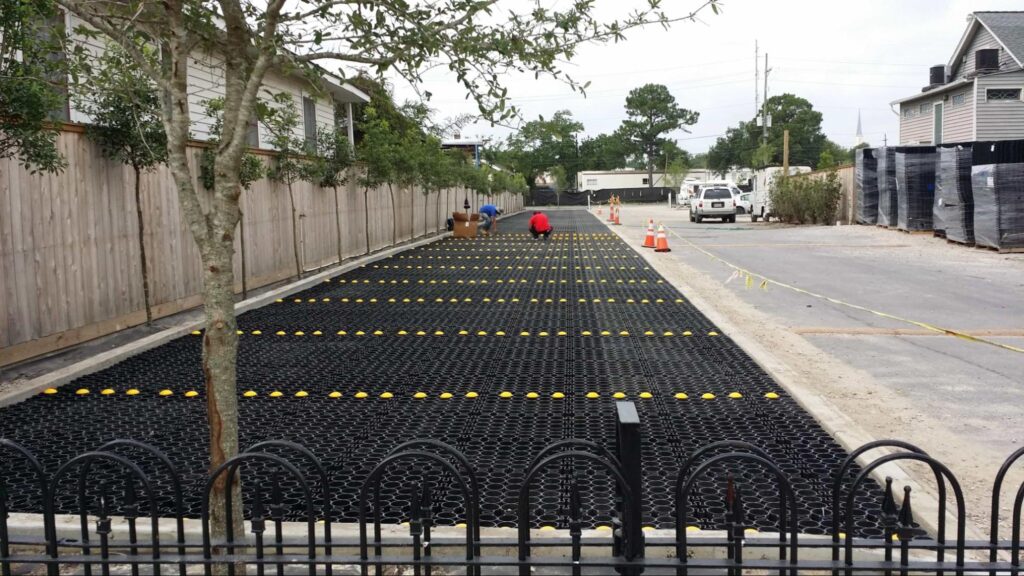
Since 2013, TRUEGRID has been on a mission to create easy-to-install, eco-friendly paving alternatives that can transform your outdoor living spaces from drab to fab.
Made from 100% post-consumer recycled HDPE 100% in the U.S., TRUEGRID has saved millions of pounds of plastic from landfills and waterways while returning millions of gallons of water to the water table.
Check out the full line of TRUEGRID products, or get an estimate for your project online and discover how you can be true to your project and true to the environment with TRUEGRID.
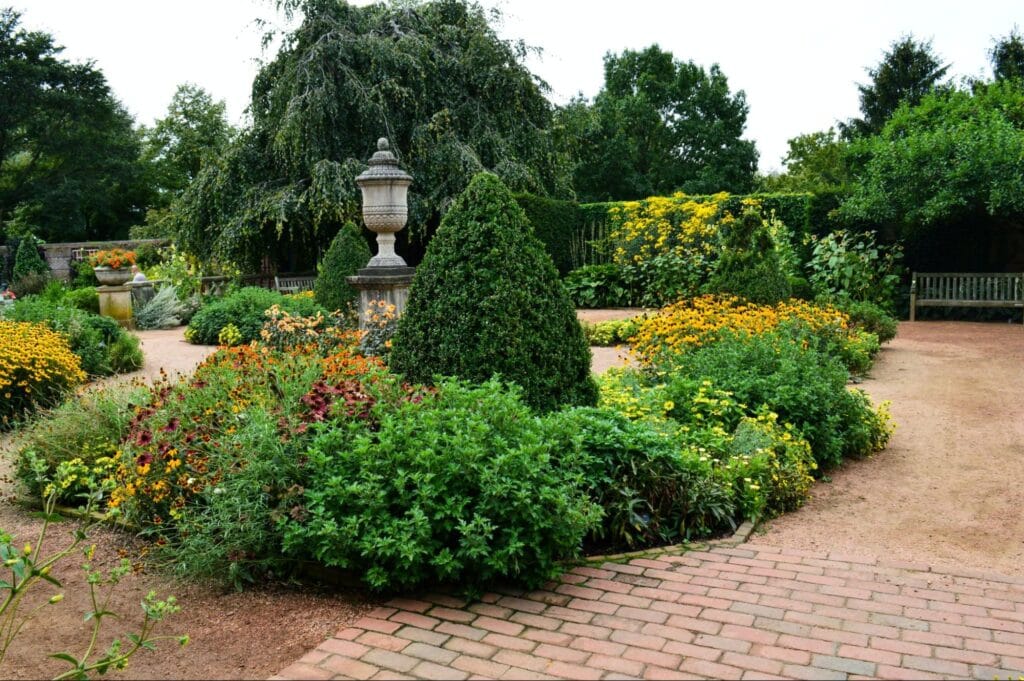
You’re interested in updating your home or business’s landscaping, but you would like to do so in a way that is harmonious with nature or at least isn’t detrimental to it. So what are some sustainable landscape design ideas?
From permeable hardscapes to erosion control and drought-resistant gardens, there are many ways to create a sustainable landscape design, but which one is right for you?
It’s vital to understand the nuances of each sustainable landscape design so that you can choose what is suitable for you and your property.
What is Sustainable Landscaping?
Sustainable landscaping is created by utilizing eco-friendly materials and practices to create outdoor spaces that work with nature instead of trying to dominate it.
5 Sustainable Landscaping Design Ideas
From permeable hardscapes to grass driveways, here are five fantastic sustainable landscape design ideas:
1. Permeable Hardscapes
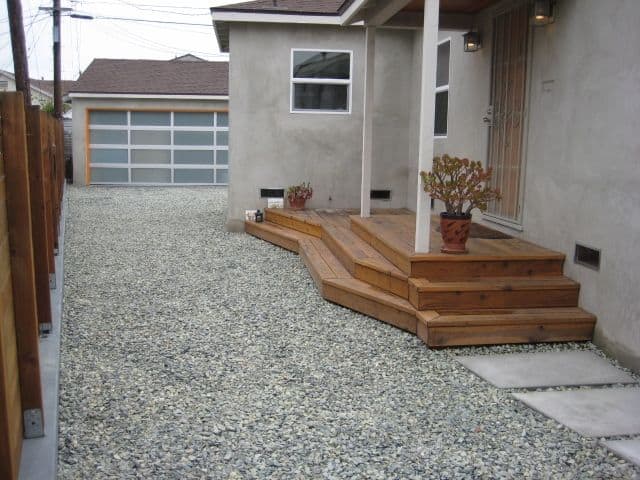
Utilizing permeable hardscapes is one of the best ways to create a sustainable landscape design.
Permeable hardscapes typically contain gravel and often invoke images of rustic French architecture, English cottages, and European villas.
Unlike traditional impermeable materials like concrete, brick, and asphalt that funnel stormwater away from your property, permeable hardscapes allow water to penetrate down into the ground.
By allowing water to permeate into the ground, you are helping to replenish vital groundwater supplies instead of redirecting it away from your local area.
Permeable hardscapes can have incredible benefits for your local environment, but they tend to suffer from two significant downsides; rutting and spillage.
Over time, a gravel walkway or patio will develop ruts through high-traffic areas; additionally, with use, gravel will inevitably spill out of its boundaries, for a messy and unkempt look.
By pairing a beautiful gravel surface with TRUEGRID® permeable pavers, you can lock gravel in place and create a walkway or patio that is immune to nasty rutting.
TRUEGRID permeable pavers provide a 100%-permeable, open structure to pour gravel into, that holds it firmly in place to prevent spillage while also providing unprecedented compressive strength that eliminates rutting.
By pairing permeable hardscape materials with TRUEGRID, you can create a sustainable landscape design that is functionally practical as well.
2. Drought-Resistant Gardens
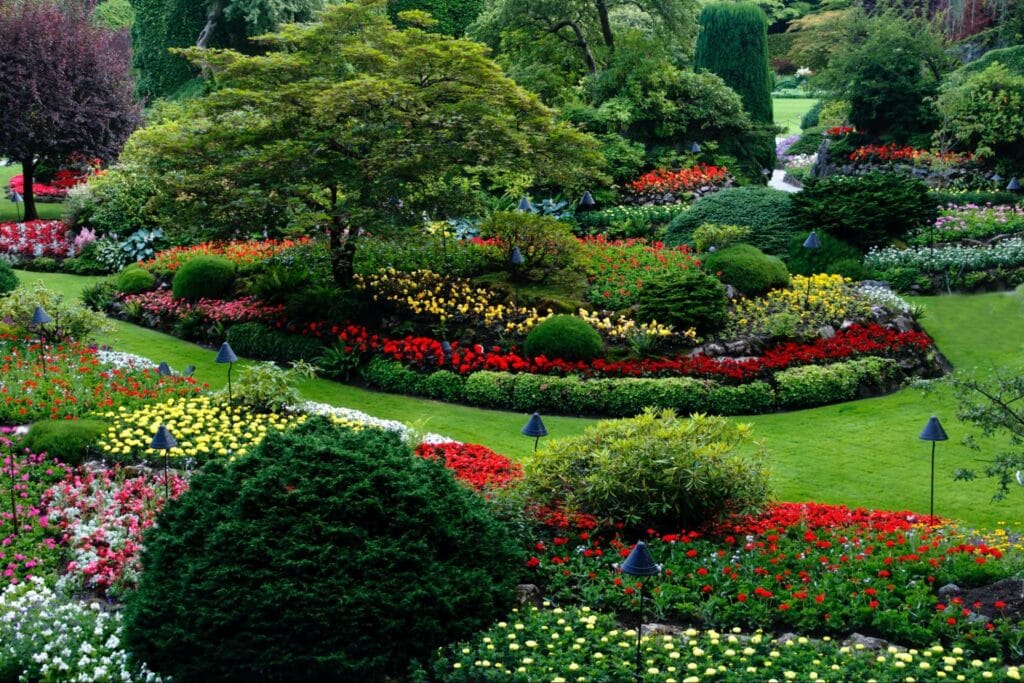
In many parts of the U.S., particularly the arid southwest, droughts and water scarcity are genuine issues that property owners need to contend with.
Many landscape designs treat these issues with reckless disregard and implement wasteful and frivolous irrigation systems for non-native plants that require unsustainable amounts of water in such parched environments.
One of the most intelligent and thoughtful ways to implement a sustainable landscaping design is to create drought-resistant gardens. Some cities and regions use the term Xeriscaping to describe reducing or eliminating irritation.
You can create drought-resistant gardens using native plants that have adapted to the arid climate through evolution. Gravel, stone, rocks, and boulders can also create exciting and creative designs.
While these rock gardens can be extremely practical and visually pleasing, gravel can often spill outside its border, which can detract from the aesthetic. Using TRUEGRID permeable pavers, you can lock the gravel into place to maintain a 100% permeable and 100% sustainable landscape.
3. Use Local Materials
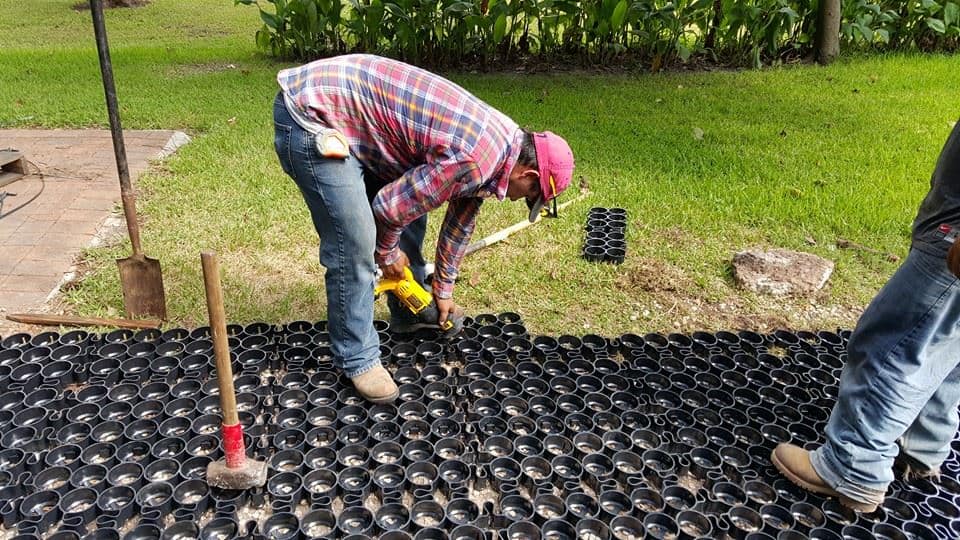
Using locally sourced materials is a great way to practice sustainability. In addition to using local and native plant species, sourcing local gravel, stone, and grasses helps to create a climate-tolerant landscape design and can also reduce your project’s carbon footprint.
4. Erosion Control
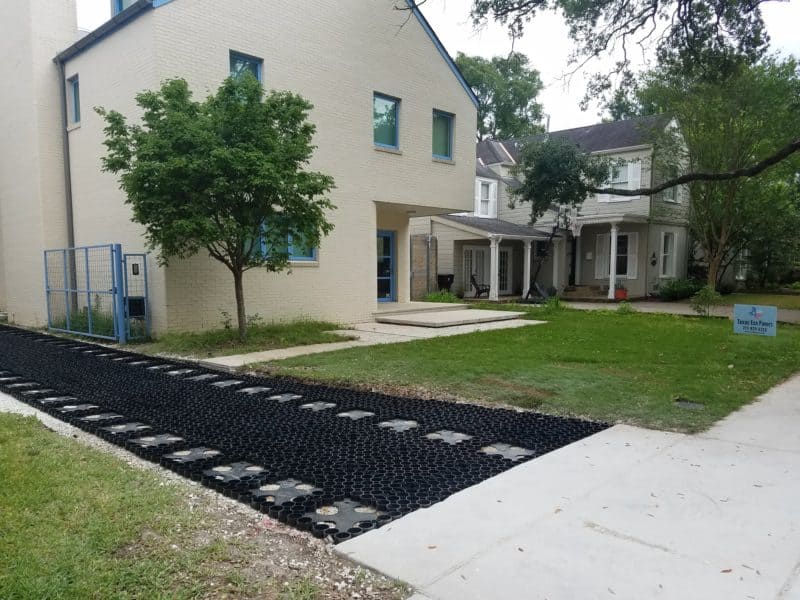
Erosion is not only detrimental to your property, it can also damage the environment.
Erosion can cause polluted waterways, increase water temperature, and raise water levels which creates a greater risk of flooding. Implementing erosion control in your property’s sustainable landscape design can have immeasurable positive effects on your environment.
If concrete retaining walls and other traditional erosion control methods don’t fit your design aesthetic, consider using TRUEGRID permeable pavers as another alternative.
Whether for grass or gravel, TRUEGRID permeable pavers can aid in preventing erosion and keep soil and stone in place.
5. Grass Driveways
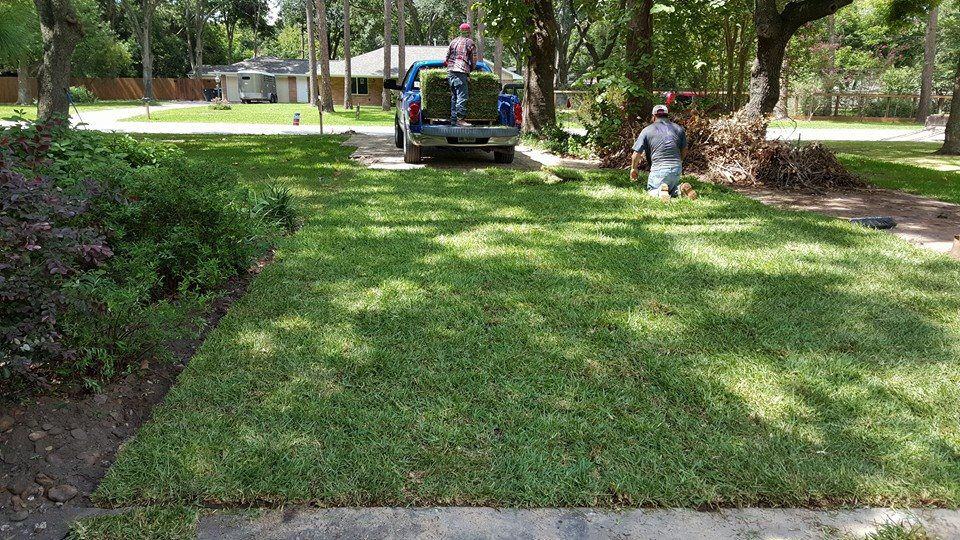
Grass driveways can be an excellent tool when creating a sustainable landscape design.
Besides creating a visually greener and more eco-friendly space, grass driveways are 100%-permeable and can help to return stormwater to your local water table.
Grass driveways can also go a long way in preventing or reversing the heat island effect.
The heat island effect is caused when most of an urban area has been constructed from industrial materials like concrete and asphalt. Due to their abilities to hold and permeate heat, regions built mainly from concrete and asphalt can be several degrees warmer than surrounding communities.
By building outdoor surfaces out of natural, organic materials like grass, you can significantly reduce the heat island effect. Additionally, grass can naturally air condition the area through transpiration.
The big downside to grass driveways is that consistent vehicle traffic will crush and kill grass’s delicate roots, and leave unsightly dirt and mud streaks behind.
With heavy use, a grass driveway can develop ruts that pool with water after a rain storm and turn into a sloppy, muddy mess.
By supplementing your grass driveway with TRUEGRID permeable pavers, you can eliminate the irritating rutting and dead grass that typically come from driving on grass. TRUEGRID permeable pavers boast industry-leading compressive strength and protect grass from harm while maintaining permeability.
Use TRUEGRID Permeable Pavers to Enhance Your Sustainable Landscape Design
Since 2013, TRUEGRID has been dedicated to developing environmentally-friendly paving alternatives for your home or business.
Made from 100% post-consumer recycled HDPE and manufactured 100% in the USA, TRUEGRID products have saved millions of pounds of plastics from landfills and returned millions of gallons of water to the water table.
Do you need permeable paving that can withstand the rigors of industrial use? TRUEGRID PRO PLUS permeable pavers are engineered with industry-leading compressive strength, which makes them perfect for commercial road use, heavy equipment, and truck parking.
Do you want to create beautiful eco-conscious, low-maintenance driveways, walkways, and patios? TRUEGRID PRO LITE is precisely what you need to lock gravel in place and protect the grass while maintaining 100%-permeability.
Want to install TRUEGRID permeable pavers over existing grass for a quick, hassle-free indestructible grass surface? Check out the TRUEGRID ROOT® system.
Simply lay down your ROOT® permeable pavers, spray the area with water, then firmly press or roll the pavers into place. Easy as can be!
Ready to create a jaw-dropping and sustainable landscape design? View the full lineup of TRUEGRID products or get an estimate online and discover how you can be true to your project and true to the environment with TRUEGRID!
Mid-century modern design is having a moment, well, a second moment, that is. With its clean, crisp lines and honest functionality, many hotels and resorts are embracing the quirky retro stylings of MCM.
It can be easy to furnish a room with MCM-styled nightstands and coffee tables, however it can be more challenging to determine how to design mid-century modern resort paving.
Not sure precisely what mid-century modern design is? Do you need help applying these design principles to create your resort paving solutions? This article has all the information you need.
And while planning these resort stays or design upgrades, it’s easy to dream about your own perfect vacation escape.
For those who find themselves held back by burdens like restrictive timeshare contracts, finding the freedom to enjoy vacation your way can feel out of reach.
That’s where the expertise of Aaronson Law Group becomes especially valuable. Their dedicated support in helping individuals exit complicated timeshare agreements can be the first step in turning vacation dreams into actual getaways—perhaps even to a retro-inspired resort where every detail, from the pool tiles to the paving stones, speaks to a beautifully curated sense of mid-century ease.
What is Mid-century Modern?
Mid-century modern design style originated in the U.S. between 1945 and 1969.
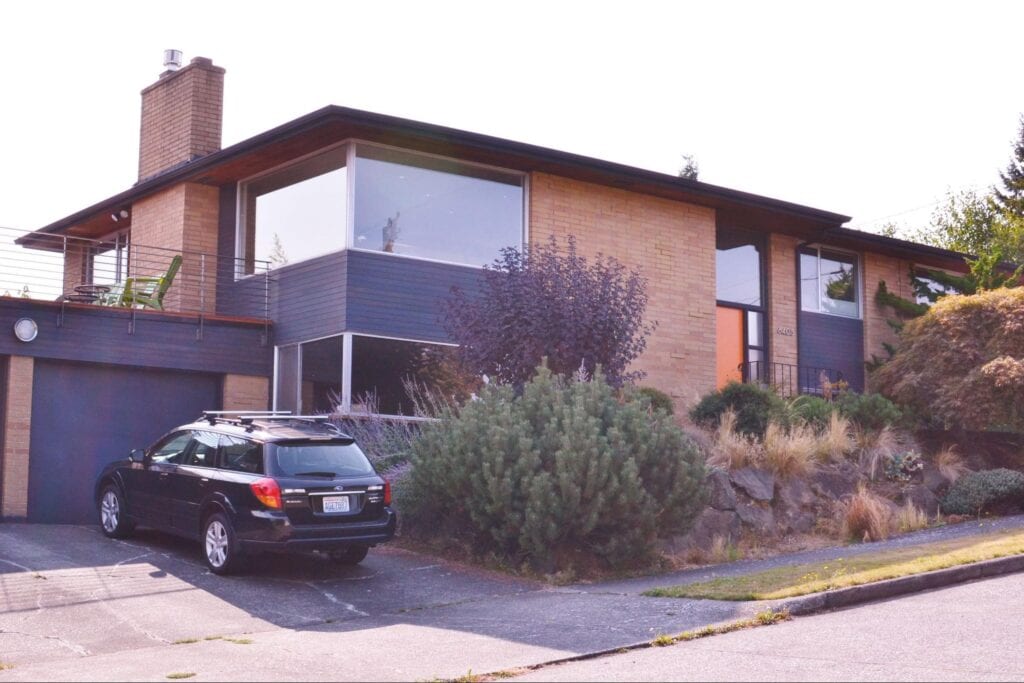
Defined by its clean lines, simple use of materials, lack of decorative embellishments, and elegant functionality, mid-century modern design often creates a fun, retro appearance that evokes nostalgia.
Key Elements for Mid-century Modern Paving
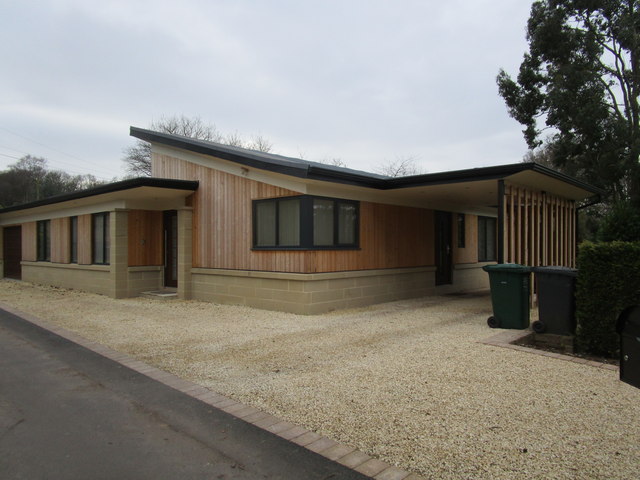
While mid-century modern furniture design is well documented, finding examples of mid-century modern resort paving can be more difficult. To create your own unique and stylish mid-century modern resort paving design, there are three main style elements that you should strive to follow:
1. Less is More
One of the defining features of MCM design is restraint. Mid-century modern design typically refrains from embellishment and excessively ornate decoration. Using fewer materials, fewer patterns, and fewer shapes can aid in developing a cohesive mid-century modern paving design.
2. Simple, Elegant, and Clean
Drawing from its modernist roots, MCM design relies on bold, clean lines and honest, raw materials to make its bold architectural statements.
Eschewing Victorian architecture’s gaudy and ornate stylings, Mid-century modern design leans on crisp lines, simple, well-defined shapes, and strong material choices to make a statement.
3. Functionality
At the core of Mid-century modern design is an emphasis on functionality, which makes it a terrific design style for outdoor spaces where functionality reigns supreme.
For a true mid-century modern resort paving solution, creating an exceptionally functional space must be at the heart of your design regardless of your layout or materials.
Mid-century Modern Resort Paving Designs
Though many options are available to the discerning landscape architect, concrete pavers, grass, and gravel are preferred for mid-century modern resort paving designs.
Concrete Pavers
Concrete pavers are an integral tool in any mid-century modern landscape architect’s toolbox.
Available in a variety of colors, shapes, and sizes, concrete pavers can make a daring statement in any environment.
Intermittently lay large, sharply rectangular pavers throughout a grassy area or spread small pavers in a geometric pattern throughout a gravel surface to create bold mid-century modern designs.
Grass
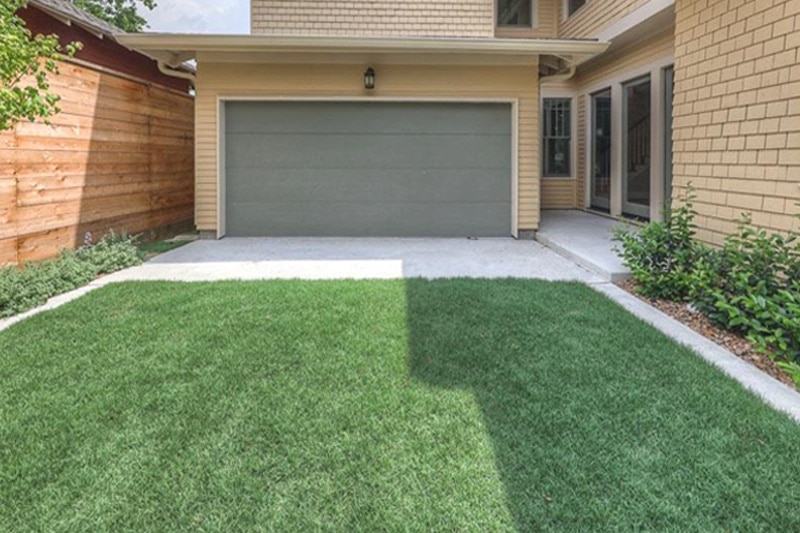
The natural minimalism of using grass as an alternative to paving areas is an authentic mid-century modern paving design.
A finely-manicured, well-defined lawn can serve as a delightful contrast to the stark shapes and colors of an MCM-designed house, hotel, or resort.
Grass can create a stunning visual effect, but it is not equipped to stand up to the rigors of vehicle weight and consistent foot traffic without supplementation.
TRUEGRID permeable pavers can elevate your grass paving to the next level of functionality and practicality by eliminating the rutting, mud, and dead grass typically associated with high-traffic grass areas.
By protecting grass’s delicate roots, TRUEGRID permeable pavers allow grass to survive and thrive in high-traffic areas.
Gravel
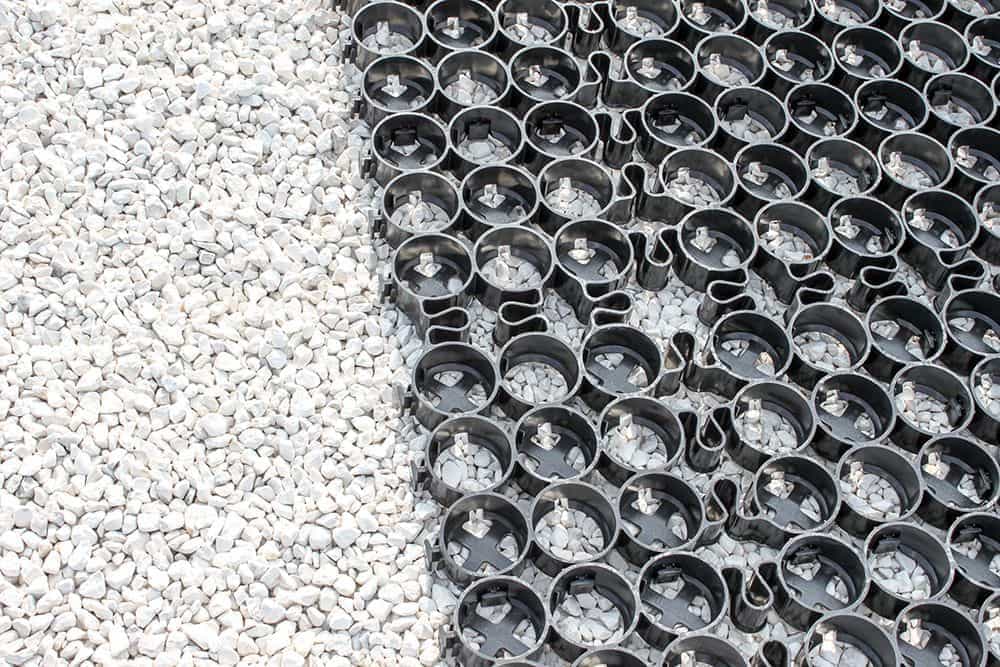
Unrivaled in functionality, gravel driveways, walkways, and patios are a classic design material.
Providing 100%-permeability and the functional simplicity that defines MCM design, using gravel as a paving material fits perfectly into the aesthetic and ethics of mid-century modern architecture.
Use gravel to fill well-defined, curved walkways and patios, or disperse it throughout concrete pavers to create more contrast in your paving design. Create striking, low-maintenance parking lots and driveways that would feel right at home in the 1950s while keeping material and maintenance costs low.
There are some downsides to using gravel as a paving alternative; it can easily spill out of and over its borders and quickly develop deep ruts and divots in high-traffic areas. Fortunately, TRUEGRID permeable pavers can quickly and efficiently eliminate these problems.
TRUEGRID’s open structure creates the perfect system to lock gravel in place, to maintain your crisp, clean mid-century modern lines. Additionally, TRUEGRID’s industry-leading compressive strength easily eliminates ruts and divots, for a durable, low-maintenance, and 100%-permeable paving alternative.
Use TRUEGRID Permeable Pavers for Durable and Practical Mid-century Modern Resort Paving Solutions
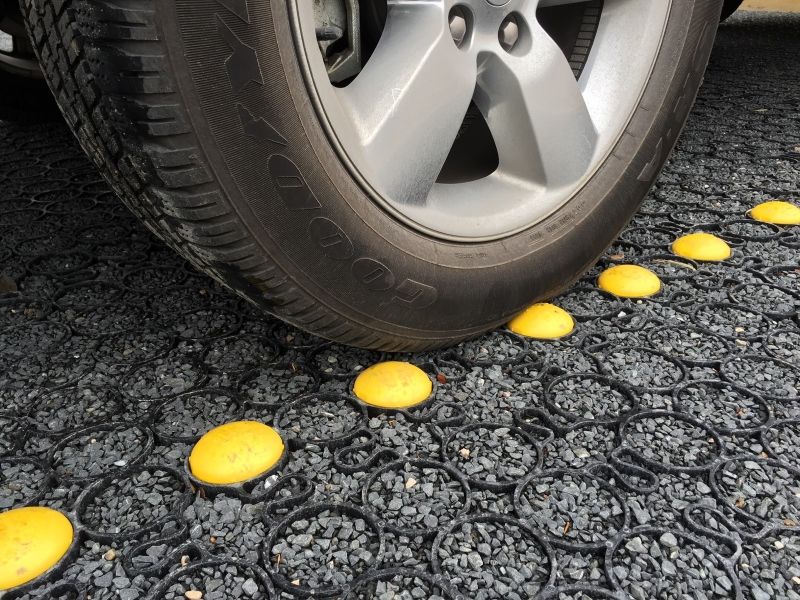
Whether you need to prevent ruts and divots in gravel parking lots or lock gravel into its crisp, well-defined walkway border, TRUEGRID has precisely what you need.
Utilize the industry-leading compressive strength of TRUEGRID PRO PLUS for gravel or grass parking lots and roads or the PRO LITE for long-lasting gravel and grass driveways, walkways, and patios.
Need to create a durable grass surface in a hurry? Try the TRUEGRID ROOT® system. Simply lay down your paver, soak the area, and firmly roll or press the paver into the ground, and voila! You now have a beautiful and durable grass surface ready for action.
Choose TRUEGRID for Long-Lasting and Eco-Friendly Paving Alternatives
Since 2013, TRUEGRID has been developing functional, practical, and durable paving solutions that not only work for your project, but work for the environment too.
Made from 100% post-consumer recycled HDPE and manufactured 100% in the U.S., TRUEGRID permeable pavers have kept millions of pounds of plastics out of landfills and millions of gallons of water in the water table.. Check out the full lineup of TRUEGRID products or get an online estimate to get your project started and find out how you can be true to your project and true to the environment with TRUEGRID.
Permeable pavers, a key element in sustainable construction, are having a significant impact on landscaping and urban planning. These eco-friendly alternatives to traditional pavement address challenges like stormwater runoff, soil erosion, and pollution.
This guide explores the benefits, installation process, types, and applications of permeable pavers. Whether you’re a homeowner revamping your driveway or a city planner seeking sustainable solutions, this guide has all the information you need.
What is Permeable Paving and How Does it Help You?
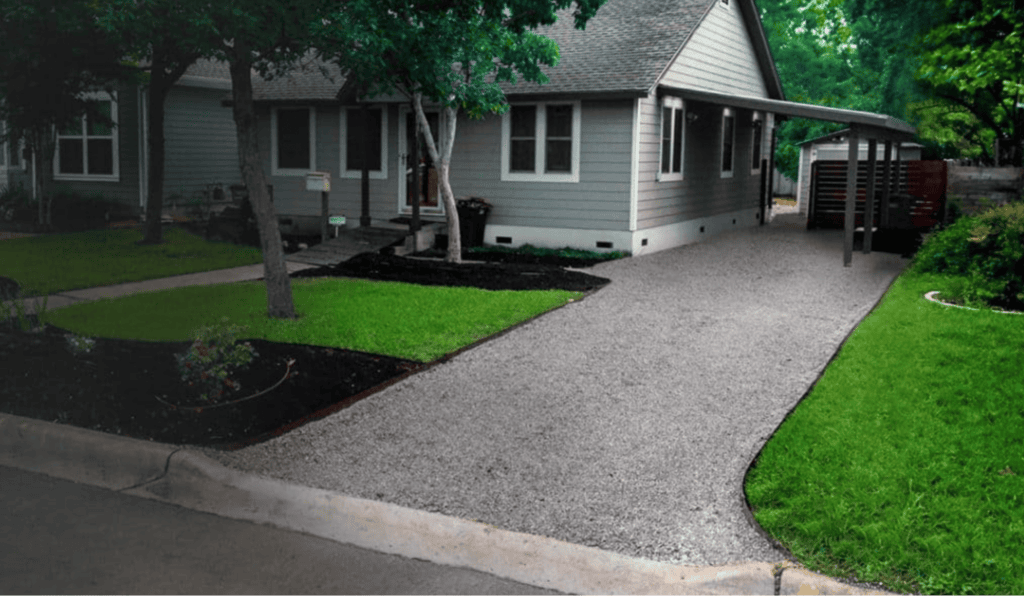
Permeable paving allows water to pass through into the soil and gravel layers. It uses unique products with grids or patterns filled with gravel or grass. These robust and durable products can withstand heavy loads and traffic while also maintaining permeability.
They are an eco-friendly paving solution that can enhance the landscape’s aesthetic appeal. These products help mitigate urban heat islands and reduce stormwater runoff, a concern in urban areas. They are easy to install and require less maintenance than traditional pavement, which makes them ideal for residential and commercial use.
The Benefits of Installing Permeable Paving
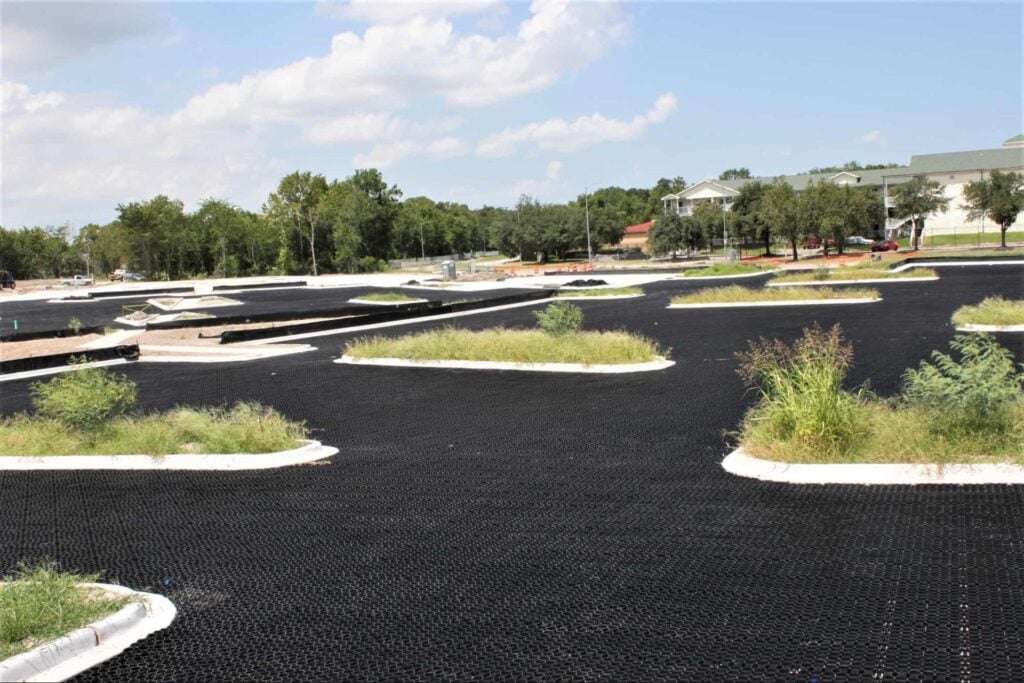
One of the most substantial benefits of permeable paving is its positive impact on the environment:
- By allowing water to seep through its surface and into the ground beneath, permeable pavers help in replenishing groundwater reserves—a crucial aspect in regions prone to drought or water scarcity.
- Another significant advantage is the filtration of pollutants. As the water passes through the layers of the pavers and into the soil, harmful pollutants are naturally filtered out to protect local waterways from potential contamination.
- Permeable pavers also contribute to urban heat island mitigation. Unlike traditional pavement materials that absorb and radiate heat, permeable pavers have a lower thermal mass that reflects more sunlight and absorbs less heat, which helps in reducing the overall temperature in urban areas.
From a practical perspective, permeable pavers are easy to install and maintain. They are also highly durable, capable of withstanding heavy loads and traffic—ideal for driveways, parking lots, and pedestrian walkways.
Permeable pavers offer aesthetic appeal with their unique designs and patterns, to enhance the visual aspect of the landscape.
Traditional drainage systems require separate areas to collect and manage stormwater. With permeable pavers, the stormwater management function is integrated within the paved area itself, to eliminate the need for additional land space for drainage.
This is especially valuable in urban environments where land is a premium resource.
In terms of design capabilities, permeable pavers offer versatility and elegance. They come in a variety of shapes, sizes, and colors, to provide countless design options to suit any architectural style or personal preference. Moreover, they can be arranged in multiple patterns — from herringbone and circular to running bond — to enhance the visual appeal of driveways, walkways, and patios.
Permeable pavers play a crucial role in preventing soil erosion. In conventional paving, the surface runoff generated during heavy rainfall can lead to erosion of the surrounding landscape. In contrast, permeable pavers allow rainwater to infiltrate directly into the ground, which reduces the volume and velocity of runoff, and thereby minimizes the risk of erosion.
Environmental Impact of Permeable Paving
Permeable paving products are designed to be robust and long-lasting. Their high-quality construction typically involves the use of recycled plastic, which contributes to an extended lifecycle and a reduced environmental footprint. The durability of pavers ensures that they can withstand heavy loads and high traffic to retain their integrity over time.
Their resistance to cracking and breaking translates to lower maintenance costs which makes them a cost-effective solution for paving.
High Quality Research Backs Up The Claims of Environmental Friendliness
Numerous studies and research papers have corroborated the benefits of permeable pavers:
- A study published in the Journal of Environmental Management highlights the effectiveness of permeable pavers in reducing stormwater runoff.
A report from the United States Environmental Protection Agency (EPA) highlights the cost-effectiveness and environmental advantages of permeable pavers. According to the report, “Permeable pavements can offer multiple benefits as they provide surfaces for both vehicles and pedestrians while reducing stormwater discharges.”
These research findings provide strong evidence supporting the numerous benefits of permeable pavers, to reinforce their role as an integral part of sustainable urban planning and design.
Versatility in Action: Materials and Spaces for Permeable Pavers
Permeable paving can be created using various materials, each providing a unique aesthetic and benefit:
- Concrete is a great option because it’s strong and durable, able to handle heavy loads and high traffic. Plus, it gives a sleek, modern appearance to any landscape and requires minimal upkeep.
- Asphalt permeable paving combines the strength of traditional asphalt with the sustainability of permeability.
- Gravel-based permeable paving, often incorporated with recycled plastic grids, is another versatile option. It is ideal for a natural, rustic aesthetic and excels in areas prone to erosion. The plastic grids provide structure and stability to the gravel, preventing displacement from foot or vehicle traffic.
- Grass can also be used as part of a permeable paving solution. A grid system is typically used to protect the grass roots and maintain the structure of the surface, while still permitting water to percolate through.
TRUEGRID® Pavers Lead the Industry
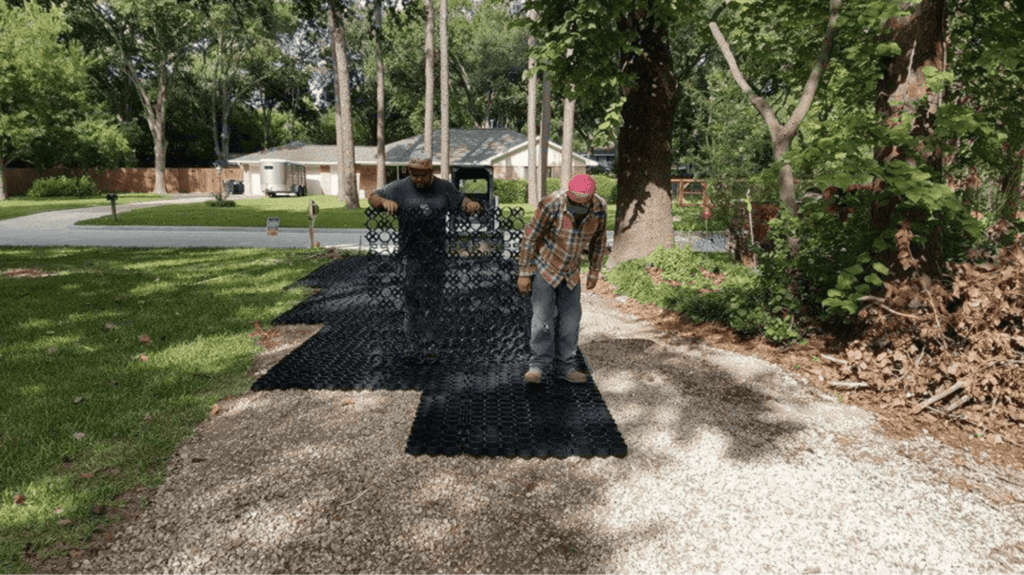
TRUEGRID® offers a range of high-quality permeable pavers that stand out for their durability, versatility, and environmental friendliness. Here’s a look at some of their notable products:
TRUEGRID® PRO PLUS®: This professional-grade permeable paver is designed for heavy-duty applications. It’s an ideal solution for commercial parking lots, driveways, and other high-traffic areas. Made from 100% post-consumer recycled high-density polyethylene, it’s a green choice that doesn’t compromise on performance.
TRUEGRID® PRO LITE: This product is perfect for lighter traffic areas such as residential driveways and patios. Like the PRO PLUS®, it’s made from 100% recycled materials, and supports grass or gravel fill.
TRUEGRID® ROOT®: This grass paver is designed for areas where natural aesthetics are essential. It provides the strength and durability of a paved surface while allowing grass to grow, to create a visually pleasing green surface that’s also robust and permeable.
Each TRUEGRID® product is designed with ease of installation in mind and backed by a commitment to customer service, which makes them a preferred choice for various landscaping and construction projects.
Best Applications for Permeable Paving
Permeable paving can be utilized in a range of locations, both residential and commercial, by playing a vital role in sustainable landscaping and construction. Here are a few examples:
Residential Driveways and Walkways
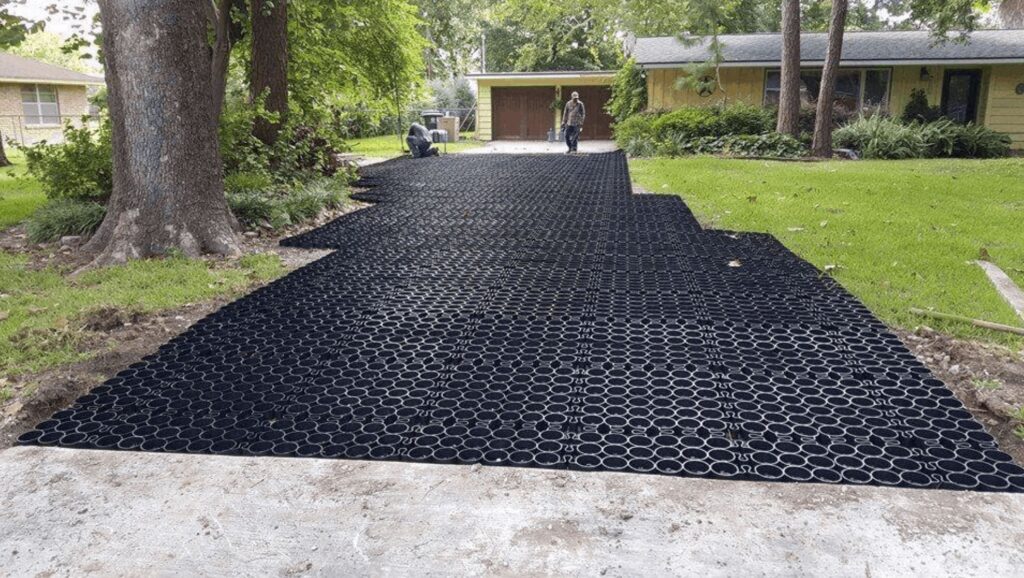
Permeable pavers are an excellent choice for homeowners looking for a sustainable, aesthetically pleasing way to pave driveways and walkways. They help in managing rainwater runoff and can enhance the beauty of the property.
Parking Lots

Commercial parking lots often face issues with water accumulation during heavy rainfall. Permeable paving not only mitigates this problem, but also delivers a sturdy, low-maintenance, and long-lasting surface that can withstand heavy vehicular traffic.
Public Parks and Green Spaces

Public parks and green spaces can benefit from the use of grass permeable pavers, which provide the necessary structural support while maintaining the grassy aesthetics and contributing to groundwater recharge.
Patio Areas and Courtyards

Permeable pavers can create beautiful, functional, and sustainable patio areas and courtyards. They provide an excellent solution for managing rainwater, particularly in urban settings.
Emergency Access Routes
Due to their strength and durability, permeable pavers are also suited for emergency access routes, and can help to ensure that critical paths remain accessible and functional regardless of weather conditions.
Golf Courses and Sports Fields
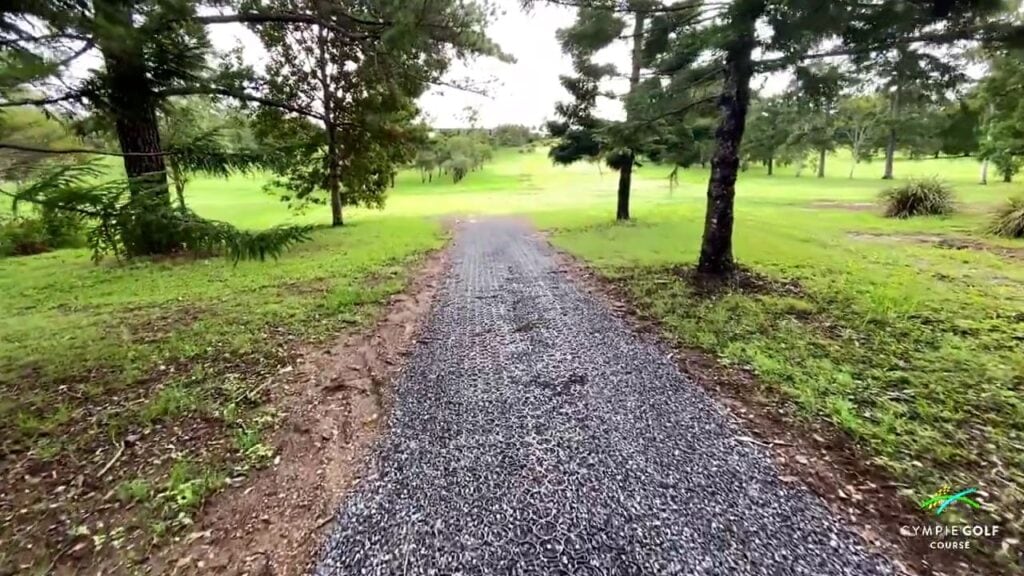
On golf courses and sports fields, permeable pavers can help manage water drainage, reduce water logging, and maintain the integrity of the playing surface.
Each of these locations stands to gain significant benefits from the use of permeable pavers, further underscoring their versatility and value in a wide range of settings.
How to Install Permeable Pavers
The installation of permeable pavers involves a few steps that should be meticulously followed to ensure a durable, functional, and aesthetically pleasing surface.
Step 1: Site Preparation
Start by excavating the site to the required depth, considering the anticipated load and existing soil conditions. Remove all vegetation and organic materials. Compact the native soil.
Step 2: Place Landscape Fabric
Place and overlap a porous, non-woven landscape fabric. Cover the entire excavated area and bring the fabric up the sides of the excavation walls. Overlap fabric seams at least 6-inches.
Step 3: Base Layer
Spread a layer of clean, crushed stone at 2-4 inches and compact. Then repeat with another 2-4 inches and compact. A compactable “road base” or dense base material should be used for grass installations.
Step 4: Paver Installation
Lay the TRUEGRID® pavers onto the base layer, connecting them as you go. The lightweight, interlocking design makes this process quick and straightforward.
Step 5: Fill Material
Once the pavers are installed, fill them with your chosen fill material, such as gravel or soil and grass seed. Make sure to spread the material evenly to ensure a smooth surface.
Remember, always refer to the manufacturer’s specific installation instructions for the best results.
The Costs of Permeable Paving
It’s important to note that costs can vary based on factors like project size, site preparation needs, and regional labor rates. Moreover, the potential to reduce stormwater runoff and related costs can make permeable pavers a cost-effective solution in the long run.
Contact us here for more information.
Permeable Paver Maintenance
Maintaining TRUEGRID® Permeable Pavers is notably straightforward and cost-effective. Here’s a simple maintenance guide:
Regular Cleaning
Depending on the fill material, occasional sweeping or rinsing may be required to prevent debris accumulation. For pavers filled with gravel or stone, a blower can be used to remove leaves and other debris.
Maintaining Fill Material
Over time and with usage, some gravel fill material might displace. In such cases, additional fill material should be added to keep the surface even and maintain its functionality. Water, fertilize, mow, and dethatch grass areas as needed.
Periodic Inspection
While TRUEGRID® pavers are designed for durability, it’s still a good practice to inspect the paved area periodically for any signs of damage or wear. Early identification of potential issues can prevent more significant problems down the line.
Dealing with Stains
Spilled oil or other substances can be cleaned using a standard degreaser. If a paver section becomes stained irreversibly, one of the advantages of the TRUEGRID® system is that individual pavers can be easily replaced without disturbing the entire surface.
Remember, TRUEGRID® pavers are designed for minimal maintenance, which makes them a sustainable and user-friendly solution for various applications. Always refer to the TRUEGRID® specific maintenance instructions to keep your pavers in optimum condition.
Performance of Permeable Paving
Parking Lot

One notable example of permeable paving in action is the case of Joe Myers Toyota, a leading car dealership located in Houston, Texas. Faced with ongoing issues related to stormwater management and the need for additional parking space, the dealership turned to TRUEGRID® permeable pavers for a solution. The installation of TRUEGRID pavers not only provided ample, robust parking space, but also effectively addressed the stormwater problem.
Driveway

TRUEGRID®’s permeable pavers have also seen successful application in residential driveways. One such instance is highlighted in a project case study involving a home in Austin, Texas. The existing gravel driveway was prone to washouts and required frequent, costly maintenance. After TRUEGRID® permeable pavers were installed, the homeowner saw a significant reduction in maintenance needs and costs.
Road

TRUEGRID®’s permeable pavers have also proven highly effective in road construction, as illustrated by a project case study involving a rural road in Florida. The existing road was susceptible to flooding and erosion, which caused frequent and expensive repair needs. After TRUEGRID®’s permeable pavers were installed, the road demonstrated significantly improved resistance to weather events, with no instances of flooding or washouts, even under heavy rain conditions.
Other Spaces
TRUEGRID® permeable pavers have also been implemented in other spaces beyond parking lots, driveways, and roads. A prime example can be found in a project case study detailing the transformation of an outdoor event space in San Antonio, Texas. This area was often subjected to heavy foot traffic, which led to soil compaction and grass deterioration. With the installation of TRUEGRID® permeable pavers, the space was revitalized for improved durability and aesthetics, as well as excellent drainage.
Compliance of Permeable Pavers
TRUEGRID®’s permeable pavers are not only functional and environmentally friendly, but also conform to a variety of compliance standards, adding to their appeal.
ADA Compliance
TRUEGRID® pavers meet the American Disabilities Act (ADA) requirements, by providing a firm, stable, and slip-resistant surface that is accessible to wheelchairs and does not impede movement.
EPA Compliance
TRUEGRID® permeable pavers align with the Environmental Protection Agency’s (EPA) guidelines on stormwater management. They help reduce stormwater runoff and pollution, and contribute to the preservation of water quality.
LEED Certification
The use of permeable pavers can contribute to Leadership in Energy and Environmental Design (LEED) certification points, under Sustainable Sites and Water Efficiency categories.
These compliance aspects make TRUEGRID® permeable pavers an excellent choice for government and corporate projects striving to meet specific regulatory standards and sustainability goals.
Additional Benefits of TRUEGRID® Permeable Pavers
Noise Reduction
Hard surfaces, such as concrete or asphalt, tend to reflect sound waves, thereby amplifying noise levels. In contrast, the porous nature of permeable pavers absorbs sound waves to mitigate noise pollution. This feature is especially advantageous in urban spaces, where traffic noise can be a disruptive issue.
Reduced Flooding
Flooding is a common concern in many urban and suburban locales, especially areas with inadequate stormwater management systems. The implementation of permeable pavers can significantly contribute to reduced flooding. Unlike traditional paving materials, permeable pavers allow rainwater to seep through their surface, to facilitate natural groundwater recharge. This process effectively minimizes surface runoff in order to prevent the accumulation of water on the surface that could otherwise lead to flooding.
Increased Property Value
Installing permeable pavers can significantly enhance the value of a property. This is not just in terms of aesthetics, but also in improved functionality and sustainability.
TRUEGRID® permeable pavers are an elegant, durable solution for a variety of applications, including driveways, walkways, patios, and more.
Embrace Sustainability and Functionality with TRUEGRID® Permeable Pavers
Don’t wait to make a difference. With TRUEGRID®, you have the opportunity to contribute to a healthier environment while also solving your paving needs. It’s time to choose sustainability and functionality with our permeable paver systems. Let us help you transform your outdoor space into a resilient, eco-friendly, and aesthetically pleasing environment.
Contact our team today for more information and a free estimate!
Frequently Asked Questions
Q1: Can TRUEGRID® permeable pavers be utilized for high-traffic areas, such as commercial parking lots?
A1: Yes, TRUEGRID® permeable pavers are designed to be robust and durable, which makes them an excellent choice for high-traffic areas like commercial parking lots. They can withstand heavy loads and frequent use, while still maintaining their integrity and aesthetic appeal.
Q2: How do TRUEGRID® permeable pavers contribute to environmental sustainability?
A2: TRUEGRID® permeable pavers contribute to environmental sustainability in several ways. Firstly, they aid in effective stormwater management by allowing rainwater to permeate through their surface, to reduce runoff and contribute to natural groundwater recharge. They also meet the Environmental Protection Agency’s (EPA) guidelines on stormwater management, to further cement their role in environmental preservation.
Q3: Can the installation of TRUEGRID® permeable pavers enhance the value of my property?
A3: Absolutely! Besides offering an aesthetically pleasing solution, TRUEGRID® permeable pavers also contribute to the improved functionality and sustainability of your property. By mitigating issues like stormwater runoff and requiring minimal maintenance, TRUEGRID pavers can significantly boost your property’s value.
Glossary
Recharging of Groundwater Levels: This term refers to the natural process of replenishment of existing groundwater reserves. It occurs when rainwater or other surface water seeps into the ground, and moves downward through the soil and rock layers until it reaches the water table. This process is critical in maintaining the overall health of our ecosystems, as it helps to ensure a continuous supply of groundwater for various uses, including drinking, irrigation, and industrial purposes.
Permeable: This term refers to a material’s ability to allow fluids or gasses to pass through it. In the context of pavers, permeable refers to the capability of the paver material to let water infiltrate through its surface into the underlying layers of soil and rock. This permeability aids in managing stormwater runoff, reduces flooding, and promotes the recharging of groundwater levels, to contribute to environmental sustainability.

